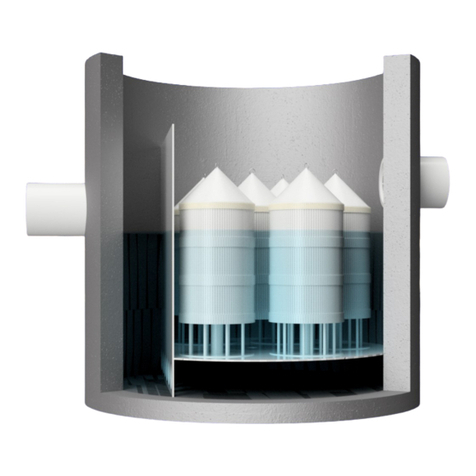Introduction
The Hydroguard is a state of the art hydrodynamic separator. Hydrodynamic separators
remove solids, debris and lighter than water (oil, trash, floating debris) pollutants from
stormwater. Hydrodynamic separators and other water quality measures are mandated
by regulatory agencies (Town/City, State, Federal Government) to protect storm water
quality from pollution generated by urban development (traffic, people) as part of new
development permitting requirements.
As storm water treatment structures fill up with pollutants they become less and less
effective in removing new pollution. Therefore it is important that storm water treatment
structures be maintained on a regular basis to ensure that they are operating at optimum
performance. The Hydroguard is no different in this regard and this manual has been
assembled to provide the owner/operator with the necessary information to inspect and
coordinate maintenance of their Hydroguard.
Hydroworks®HG Operation
The Hydroworks HG separator is unique since it treats both high and low flows in one
device, but maintains separate flow paths for low and high flows. Accordingly, high flows
do not scour out the fines that are settled in the low flow path since they are treated in a
separate area of the device as shown in Figure 1.
The HG separator consists of three chambers:
1. an inner chamber that treats low or normal flows
2. a middle chamber that treats high flows
3. an outlet chamber where water is discharged to the downstream storm system
Under normal or low flows, water enters the middle chamber and is conveyed into the
inner chamber by momentum. Since the inner chamber is offset to one side of the
structure the water strikes the wall of the inner chamber at a tangent creating a vortex
within the inner chamber. The vortex motion forces solids and floatables to the middle of
the inner chamber. The water spirals down the inner chamber to the outlet of the inner
chamber which is located below the inlet of the inner chamber and adjacent to the wall of
the structure but above the floor of the structure. Floatables are trapped since the outlet
of the inner chamber is submerged. The design maximizes the retention of settled solids
since solids are forced to the center of the inner chamber by the vortex motion of water
while the outlet of the inner chamber draws water from the wall of the inner chamber.
The water leaving the inner chamber continues into the middle chamber, again at a
tangent to the wall of the structure. The water is then conveyed through an outlet baffle
wall (high and low baffle). This enhances the collection of any floatables or solids not
removed by the inner chamber. Water flowing through the baffles then enters the outlet
chamber and is discharged into the downstream storm drain.




























